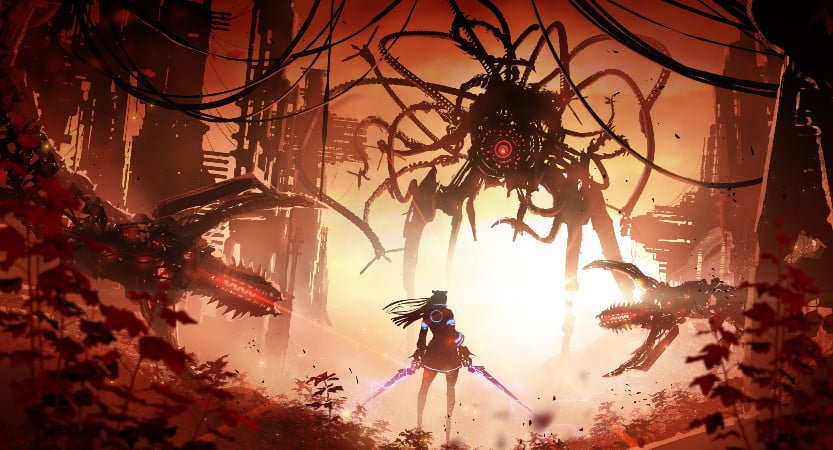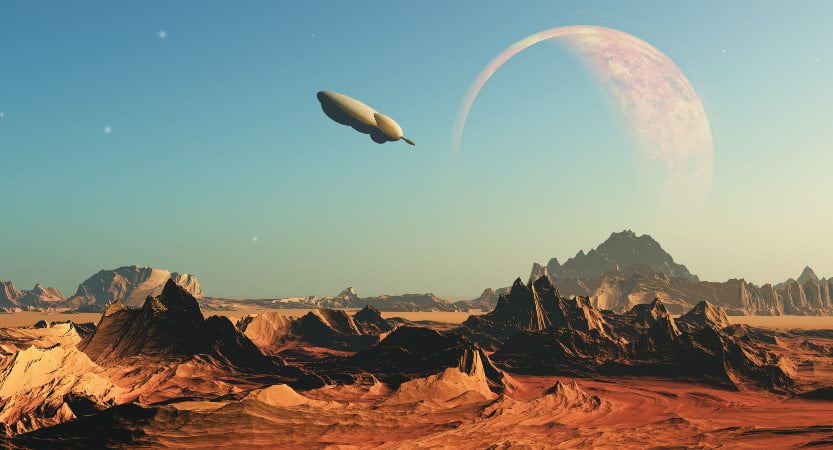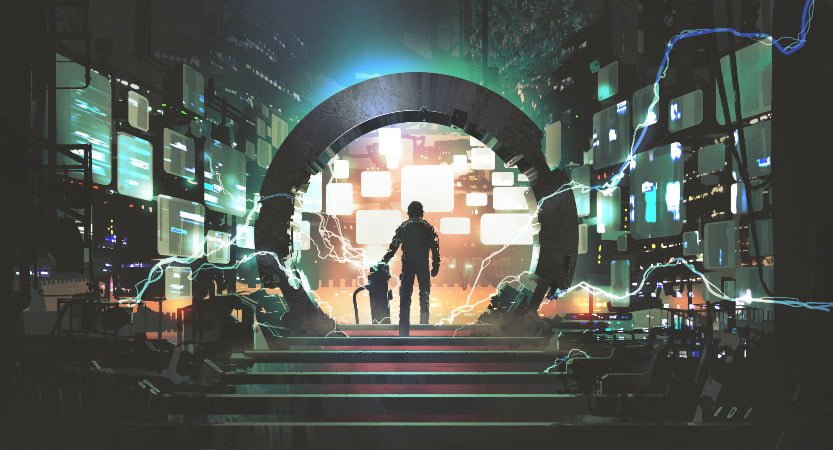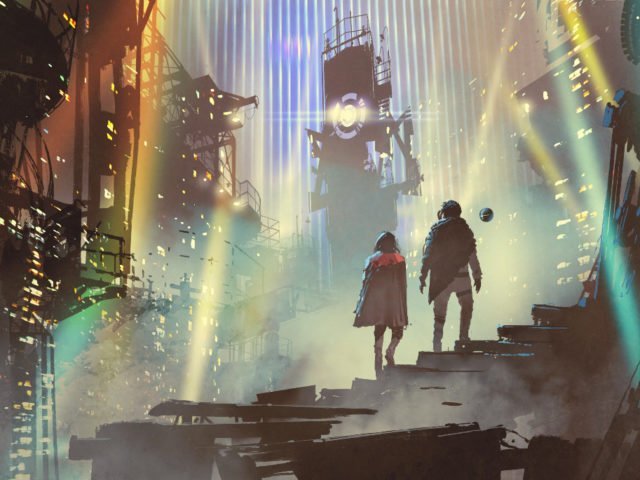Where do you start when it comes to writing a science fiction novel?
Perhaps you’ve written other genres, but just had a lightning bolt of a story idea that is definitely more of a sci fi novel. Or you’re thinking about dipping your toes into the genre but you’re not sure where to start. You may even be an existing science fiction writer who’s hit a wall and needs some tips.
In this guide to writing a compelling sci fi story, I’ll be helping you with everything you need to know about science fiction writing.
We’ll take a look at definitions, investigate subgenres, give you an overview on how to consider approaching science fiction, some tips to make things easier, and even offer a few reading recommendations.
Let’s blast off!
What Is Science Fiction?
You could debate the line between science fiction and fantasy for ages. I actually did just that in college, when I took Philosophy of Science Fiction.
Every time the class thought they’d settled on an answer, the professor would ask a question that would topple our logic like Jenga blocks. It was great.
When I lecture on science fiction now, I tend to use the useful shorthand by John Clute (author of the Encyclopaedia of Science Fiction), who calls it an “argued departure from reality,” while fantasy is more of an “unargued departure from reality.”
In science fiction, you tend to explain what that departure from our reality is in terms of technology, whereas magic in fantasy tends to be more unknowable. But there are multiple examples that could throw that definition out (Dune and Star Wars have plenty of unargued elements to them, for example).
Many others have offered up definitions, from the very academic (Darko Suvin: “a literary genre whose necessary and sufficient conditions are the presence and interaction of estrangement and cognition, and whose main formal device is an imaginative framework alternative to the author’s empirical environment”), or through the lens of industry (Hugo Gernsback: “a charming romance intermingled with scientific fact and prophetic vision.”). One of the most straightforward ones is by Norman Spinrad: “Science fiction is anything published as science fiction.”

Sci Fi Genre And What It Means
Science fiction, like any genre, is also not a monolith. There are many subgenres, and it’s useful for you to know where your story might fit in the marketplace. The biggest delineation is between hard science fiction and soft science fiction:
Hard science fiction: This type of science fiction relies heavily on science fact, making sure to explain many of the intricacies to the reader and making it a key part of the plot. The science is usually already established as fact or based on current firm theories of how the universe works (for example, working from our current knowledge of black holes or space travel).
Examples: The Martian by Andy Weir, Jurassic Park by Michael Crichton, The Expanse by James S.A. Corey, Beggars in Spain by Nancy Kress.
Soft science fiction: This type of science fiction has less focus on the technical aspects and focuses more on the societal, historical, or psychological effects of technology. The technology might not be as deeply explained or less theoretically possible (time travel, faster than the speed of light travel, etc).
Examples: Brave New World by Aldous Huxley, The Left Hand of Darkness by Ursula K. Le Guin, Becky Chambers’ Wayfarers series.
But like the definitions between science fiction and fantasy, this is a false binary. There are plenty of science fiction books that blend the two, and many are more “soft boiled” science fiction. Even the same authors can move around on the spectrum.
This brings us to subgenres.
Science Fiction Subgenres
Going into detail about these would make this article too long, so this is a list. Feel free to research any of these in more depth if you think this is an area you already write or would like to try writing:
- Dystopian
- Utopian
- Artificial intelligence
- First contact
- Military science fiction
- Parallel universes/the multiverse
- Space opera
- Space western
- Space horror
- Steampunk
- Solarpunk
- Silkpunk
- Biopunk
- Cyberpunk
- Portal fantasy
- Afrofuturism
- Alternate history
- Alien invasion
- Ecofiction
- Feminist science fiction
- Mundane science fiction
- Recursive science fiction
- Slipstream
- Science fantasy
…and many more.
The good news is that, when in doubt, you can always use “speculative fiction” as a catchall, but narrowing down your subgenre will likely make it easier to pitch to agents, editors, or sell to an audience.
For example, Analog science fiction magazine prefers harder science fiction, so a very soft science fiction story is less likely to be picked up by them.

How To Write Science Fiction
Now that I’ve set up the definitions and given you a peek at science fiction’s many subgenres, how should you actually go about writing it?
You can do these steps in any order that works for you: this is simply how I approach writing SF. To make it more concrete, I’ll use a couple of examples from my own science fiction novel Goldilocks (a near future space thriller), because I know my own writing process best and why I made certain decisions.
Step 1: Think About Your Concept And The What If Question
All science fiction writers know that SF especially lends itself well to high concepts and catchy hooks.
This through-line will help keep many elements cohesive, and also make it easier to pitch. You can try framing it as a what if question? Examples:
- What if aliens came not to destroy us, but to save us from ourselves?
- What if an artificial intelligence gained sentience and disagreed with its programmer’s directions?
- What if climate catastrophe meant everyone had to live underwater for the next 100 years?
For Goldilocks, it was “What if five women stole a spaceship to travel from a dying, increasingly patriarchal Earth to the exosolar planet that is humanity’s last hope?”
Step 2: Decide On Your Subgenre
Often, that ‘what if’ question will point to one of the earlier mentioned subgenres. If not, you might need to skip this step for now and come back to it after you have a firmer handle on the plot and world.
For Goldilocks, I knew it needed to be set in space. As a pitch, it was The Martian meets The Handmaid’s Tale, which meant a blend of hard and soft science fiction. I knew there would be no aliens, but I wanted the space travel science to be as accurate as possible. So the area of the market became obvious early on: feminist science fiction, set in space, with elements of thriller for the plot engine.
Step 3: Create A Character
I find that this method works best:
I usually start with a character and then build the world around them by asking myself lots of questions.
- What job is your main character going to have?
- Why are they the person at the centre of this story?
- How do they instigate change in this world?
- How would they speak? What’s their background and story?
- How will they change as the story progresses?
These are general questions I ask of any character in any genre.
I decided to make my main character a botanist, in charge of growing the food on the spaceship. I felt more confident in researching this area of science compared to engineering or medicine since I don’t have a science background myself. I also realised early on that growth and nature vs. nurture are major themes in the book, so this tied in nicely as well.
Step 4: Create A World Or Universe And Begin Necessary Research
If you’re doing a far future space opera that spans multiple planets, then you’ll be creating many worlds. If you’re going a few years into the future of Earth, then you’ll be asking yourself what changed and what factors fed into it.
Worldbuilding is an exercise in cause and effect. If this, then that. If I tug this thread of a web, what vibrations will move into other areas?
I knew that my future Earth was going to be very sexist, especially in America. I started thinking through basically my nightmare scenario. I wanted it to be a bit less obvious than some other feminist dystopian novels—something that happens so gradually, that you don’t even realise you’re a frog in a pot until you’re already cooked.
Step 5: Start Building The Plot And Deciding On Structure
Throughout your pre-writing work, you’ll likely have already seen some necessary plot points starting to fall into place. You can then begin to weave these together and figure out how you’ll lay it all out on the page.
We have plenty of useful information on plot and structure to help you in this area. Or, if you’re not a pre-planner, then you can skip this step and simply start writing with your concept, character, and world in mind and see what happens.

Writing Science Fiction: Additional Tips
Here are some other things you can keep in mind as you create your science fiction novels:
1. Make Your World Believable, No Matter What Amazing SF Trappings You Include
Readers want to be transported to another world and have it feel like actual people live there, that there was a long history before the book began, and that the world will continue turning once we’ve finished the last page.
Becky Chambers does a great job of this by considering the different languages and customs of her various alien races, even if some of them look very fantastical: lizard people, sentient llama-like people, giant froggy-type aliens that move around in carts, etc. Taboos and social behaviours are also clearly detailed.
When a world feels real, then the reader will suspend disbelief in some of those more out-there elements you include.
2. Consider What Your Characters Know And How To Balance Exposition
If your character is an astronomer, then they’ll be able to explain and understand the meteoroid heading towards Earth. If they are an elementary school art teacher, they might need someone to explain it to them or to do some research themselves. One of the main challenges of science fiction and fantasy is weaving in that exposition so seamlessly that the reader doesn’t quite realise how carefully the world is being constructed around them on the page. Linden A. Lewis does this well in The First Sister, which is centred around a priestess of a sisterhood who travels with soldiers of Earth and Mars and has no bodily autonomy.
3. Do Your Research
Even if you’re writing something relatively soft or toeing the line of science fantasy, you’ll likely still need to do some research around the tech or futuristic idea you’re investigating.
Do initial research yourself, to narrow down your focus. There is SO MUCH information at your fingertips. YouTube, podcasts (I recommend NASA’s Houston We Have a Podcast if you’re writing space stuff), pop science fiction articles, academic articles not behind a paywall if you’re not able to access certain databases, social media threads or videos (check out Swapna Krishna’s TikTok for more cool space/tech stuff). Wikipedia can be a great starting point and then you can follow the linked sources at the bottom.
Sometimes, though, even all the research can make it hard to answer a specific problem.
In my experience, if you politely ask an expert a short, pointed question, they’re often happy to answer a science fiction writer. They’re excited that their expertise can be shared in a different medium and potentially reach different audiences.
For Goldilocks, I was able to interview the former head of life sciences at the Johnston Space Center, a doctor studying the effects of microgravity on the human body, experts in infectious diseases, a professor of space law, astrophysicists, and many more. Some I found through friends in my existing network, but others I emailed cold. I made sure to try and use as little of their time as possible by doing the initial legwork myself, making the question as narrow as possible. Make sure to thank them in the acknowledgements if your story is published!
4. You Don’t Have To Put In ALL The Research You Did
Yes, we know it’s a very cool fact that the enormous dust cloud at the centre of the Milky Way would taste like raspberries and smell like rum if you were able to smell or taste in space without instantly dying, but does that fact actually add anything to your narrative, or are you just wanting to show off the research you did?
Everything you include should in some way advance the characterisation, plot, or world of your story as you go along. Too many random tangents and asides that don’t actually serve the story may frustrate the reader.
5. Don’t Hit The Reader Over The Head Too Obviously With The Message
One of the big benefits of science fiction is that you are often giving some sort of prophetic vision: beware, if we don’t change our ways, we might end up like this. Or: how would humanity react to a certain event?
Yet no matter how futuristic your story is, you’re still writing to a contemporary audience and usually commenting on something that’s important to us today: climate change, rising bigotry and xenophobia, the threats to democracy, the costs of war or unregulated capitalism. Ultimately, a lot of science fiction asks us: what does it mean to be human?
Yet if you’re too didactic or preachy in the message, then it can come off as sanctimonious. It often needs to be subtle or filtered through a couple of characters who all have different opinions on whatever theme you’re investigating. Let the reader come to their own conclusions, and it will be more satisfying.

Frequently Asked Questions
What Makes Good Sci Fi?
A good sci fi novel or movie asks a ‘what if’ question (usually centred around science and technology) and answers it in a realistic yet captivating way. For a science fiction book to be engaging it has to feel like those events could, or may, happen in the future.
Who Wrote The First Science Fiction Novel?
Mary Shelley’s Frankenstein (1818) helped define the science fiction novel and genre as a whole, making it one of the oldest famed literary works of its kind.
What Is The Difference Between Science Fiction And Fantasy?
In science fiction, the author explains the departure from our reality in terms of science and technology, whereas magic in fantasy tends to be more unknowable. Although both genres are often set in worlds that do not exist, sci fi is based on the human ability to invent and grow technologically whereas fantasy can have magic systems that exist inexplicably.
You’re Now Ready To Write A Science Fiction Book
It’s beneficial for authors to explore the foundations of science fiction to help them write it. There are occasionally authors who write science fiction but don’t read it, and sometimes it is obvious. There’s an existing conversation that has been going on all the way back to Frankenstein or The Blazing World. Read the classics, read some contemporary authors. Read science fiction from various countries or in translation. Check out the winners and those shortlisted for the Hugo or Nebula awards. Read the short stories in magazines like Apex or Beneath Ceaseless Skies.
And then go forth and make up your own worlds and universes. The stars are limitless!
Jericho Writers is a global membership group for writers, providing everything you need to get published. Keep up with our news, membership offers, and updates by signing up to our newsletter. For more writing articles, take a look at our blog page.











